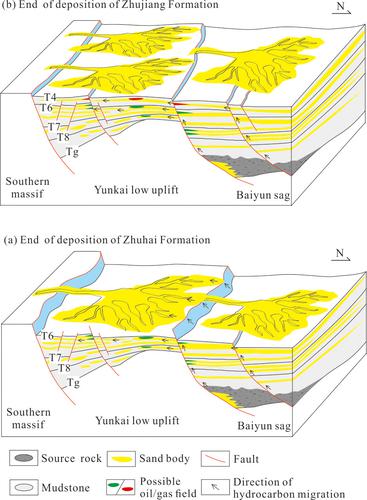当前位置:
X-MOL 学术
›
Acta Geol. Sinica Engl. Ed.
›
论文详情
Our official English website, www.x-mol.net, welcomes your feedback! (Note: you will need to create a separate account there.)
Structural Characteristics and its Significances on Hydrocarbon Accumulation in the Yunkai Low Uplift, Pearl River Mouth Basin
Acta Geologica Sinica-English Edition ( IF 3.3 ) Pub Date : 2021-01-08 , DOI: 10.1111/1755-6724.14622 Yixin YU 1, 2 , Tianlong ZHANG 3 , Zhongtao ZHANG 4 , Gongcheng ZHANG 5 , Jianhui ZEN 1, 2 , Haizhang YANG 5 , Zhao ZHAO 5 , Weiwei LIANG 3
Acta Geologica Sinica-English Edition ( IF 3.3 ) Pub Date : 2021-01-08 , DOI: 10.1111/1755-6724.14622 Yixin YU 1, 2 , Tianlong ZHANG 3 , Zhongtao ZHANG 4 , Gongcheng ZHANG 5 , Jianhui ZEN 1, 2 , Haizhang YANG 5 , Zhao ZHAO 5 , Weiwei LIANG 3
Affiliation

|
The Yunkai low uplift with low exploration degree is close to the Baiyun sag, and has hydrocarbon exploration potential in the deepwater area of the Pearl River Mouth Basin. Based on seismic and drilling data, balanced profiles and growth strata, this paper mainly discusses geological structures and formation processes of the Yunkai low uplift, and also analyzes the characteristics of fault system and their influence on hydrocarbon migration and accumulation. The EW‐trending basement faults divide the Yunkai low uplift into two parts, i.e. the southern sector and the northern sector. The northern sector is a relatively wide and gentle uplift, while the southern sector is composed of two secondary half‐grabens with faulting in the south and overlapping in the north. The Yunkai low uplift experienced three major formation stages, including the rapid uplifting stage during the deposition period of the Eocene Wenchang Formation, the slow uplifting stage during the deposition period of the Late Eocene‐Middle Miocene Enping‐Hanjiang formations, and the whole burial stage from the Middle Miocene to present. The extensional faults in the Yunkai low uplift and its adjacent areas strike mainly along the NW, NWW and near‐EW directions. Also, the strikes of faults present a clockwise rotation from the deep to the shallow strata. According to effects of faults on hydrocarbon accumulation, the faults in the Yunkai low uplift and its adjacent areas can be divided into trap‐controlled faults and source‐controlled faults. The trap‐controlled faults control trap development and can effectively seal oil and gas. The source‐controlled faults connect directly source rocks and reservoirs, which are highly active during the rifting stage and weakly active since the Miocene. This activity features of the source‐controlled faults is beneficial to migration of the early crude oil from the Baiyun sag to the high part of the Yunkai low uplift, but is not good for migration of the late natural gas. In the Yunkai low uplift and its adjacent areas, the traps in the deep Zhuhai and Enping formations that are close to source rocks in the Baiyun sag should be the favorable exploration objectives.
中文翻译:

珠江口盆地云开低隆起的构造特征及其对油气成藏的意义
低勘探程度的云开低隆起接近白云凹陷,在珠江口盆地深水区具有油气勘探潜力。本文基于地震和钻井数据,平衡剖面和生长地层,主要探讨了云开低隆起的地质构造和形成过程,并分析了断裂系统的特征及其对油气运聚的影响。EW趋势基底断裂将云开低隆起分为两部分,即南部和北部。北部地区是一个相对较宽且平缓的隆升,而南部地区则由两个次生的半筋组成,它们在南部断裂,在北部重叠。云开低隆起经历了三个主要的形成阶段,包括始新世文昌组沉积期间的快速隆升阶段,始新世-中新世-中新世-恩平-汉江组沉积阶段的缓慢隆升阶段以及从中新世到现在的整个埋藏阶段。云开低隆起及其附近地区的伸展断层主要沿西北,西北和近东向运动。同样,断层走向表现出从深层到浅层的顺时针旋转。根据断层对油气成藏的影响,云开低隆起及其附近地区的断层可分为圈闭控制断层和源控断层。疏水阀控制的故障控制了疏水阀的发展,可以有效地密封油气。由源头控制的断层直接连接源岩和储层,自中新世以来,在裂谷作用阶段是高活性的,而活性却很弱。源控断层的这种活动特征有利于早期原油从白云凹陷向云开低隆起的高部迁移,但不利于晚期天然气的迁移。在云开低隆起及其附近地区,靠近白云凹陷烃源岩的深海珠海和恩平地层的圈闭应该是有利的勘探目标。
更新日期:2021-02-22
中文翻译:

珠江口盆地云开低隆起的构造特征及其对油气成藏的意义
低勘探程度的云开低隆起接近白云凹陷,在珠江口盆地深水区具有油气勘探潜力。本文基于地震和钻井数据,平衡剖面和生长地层,主要探讨了云开低隆起的地质构造和形成过程,并分析了断裂系统的特征及其对油气运聚的影响。EW趋势基底断裂将云开低隆起分为两部分,即南部和北部。北部地区是一个相对较宽且平缓的隆升,而南部地区则由两个次生的半筋组成,它们在南部断裂,在北部重叠。云开低隆起经历了三个主要的形成阶段,包括始新世文昌组沉积期间的快速隆升阶段,始新世-中新世-中新世-恩平-汉江组沉积阶段的缓慢隆升阶段以及从中新世到现在的整个埋藏阶段。云开低隆起及其附近地区的伸展断层主要沿西北,西北和近东向运动。同样,断层走向表现出从深层到浅层的顺时针旋转。根据断层对油气成藏的影响,云开低隆起及其附近地区的断层可分为圈闭控制断层和源控断层。疏水阀控制的故障控制了疏水阀的发展,可以有效地密封油气。由源头控制的断层直接连接源岩和储层,自中新世以来,在裂谷作用阶段是高活性的,而活性却很弱。源控断层的这种活动特征有利于早期原油从白云凹陷向云开低隆起的高部迁移,但不利于晚期天然气的迁移。在云开低隆起及其附近地区,靠近白云凹陷烃源岩的深海珠海和恩平地层的圈闭应该是有利的勘探目标。



























 京公网安备 11010802027423号
京公网安备 11010802027423号